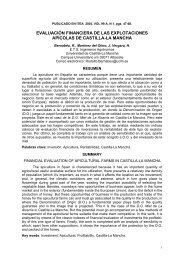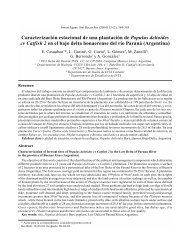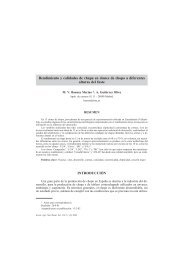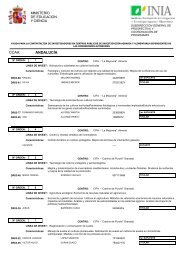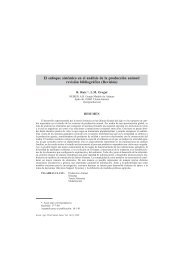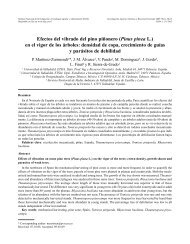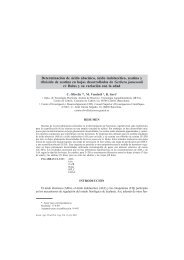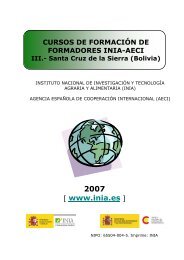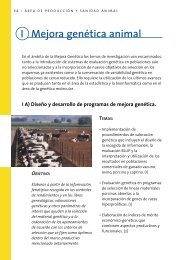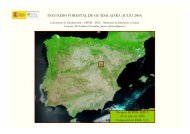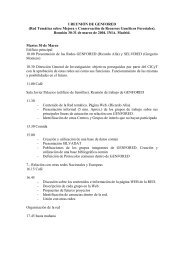Status of medicinal and aromatic plants in - Inia
Status of medicinal and aromatic plants in - Inia
Status of medicinal and aromatic plants in - Inia
You also want an ePaper? Increase the reach of your titles
YUMPU automatically turns print PDFs into web optimized ePapers that Google loves.
34<br />
WORKING GROUP ON MEDICINAL AND AROMATIC PLANTS: FIRST MEETING<br />
Legal protection, conservation <strong>and</strong> cultivation <strong>of</strong> <strong>medic<strong>in</strong>al</strong> <strong>and</strong> <strong>aromatic</strong> <strong>plants</strong><br />
<strong>in</strong> Croatia<br />
Zlatko Šatović<br />
Department <strong>of</strong> Seed Science <strong>and</strong> Technology, Faculty <strong>of</strong> Agriculture, University <strong>of</strong> Zagreb, Zagreb,<br />
Croatia<br />
Legal protection <strong>of</strong> <strong>medic<strong>in</strong>al</strong> <strong>and</strong> <strong>aromatic</strong> <strong>plants</strong> (MAPs) <strong>and</strong> their natural habitats<br />
The Law on Nature Protection (Official Gazette 'Narodne nov<strong>in</strong>e' Nos. 30/94 <strong>and</strong> 72/94) is the<br />
basic Croatian law regulat<strong>in</strong>g the issues <strong>of</strong> biological <strong>and</strong> l<strong>and</strong>scape diversity preservation.<br />
The pr<strong>in</strong>cipal <strong>in</strong> situ biological conservation method is the establishment <strong>of</strong> protected natural<br />
areas. Pursuant to the Law on Nature Protection, approximately 7.5% <strong>of</strong> the Croatian State<br />
territory is protected <strong>in</strong> this manner. This Law establishes 8 spatial protection categories<br />
(national park, park <strong>of</strong> nature, strict reserve, special reserve, monument <strong>of</strong> nature, protected<br />
l<strong>and</strong>scape, park-forest <strong>and</strong> park architecture monument). All protected areas are subject to<br />
very strict biodiversity protection measures (Radović 2000).<br />
Apart from the protected areas, certa<strong>in</strong> plant species (44) are also protected pursuant to<br />
the Law on Nature Protection (Box 1). Five out <strong>of</strong> these 44 species (<strong>in</strong> bold) are traditionally<br />
used <strong>in</strong> folk medic<strong>in</strong>e although it is not likely that overexploitation for medical purposes is<br />
the ma<strong>in</strong> reason <strong>of</strong> their rareness. However, overexploitation <strong>of</strong> related species such as<br />
Gentiana lutea L. <strong>and</strong> Paeonia <strong>of</strong>fic<strong>in</strong>alis L. has led to genetic erosion <strong>of</strong> these <strong>plants</strong> <strong>in</strong> some<br />
environments.<br />
The M<strong>in</strong>istry <strong>of</strong> Environmental Protection <strong>and</strong> Physical Plann<strong>in</strong>g is currently work<strong>in</strong>g on<br />
a Rule Book that would regulate protection <strong>of</strong> all plant species on the Red List <strong>in</strong> Croatia.<br />
The Red Data Book <strong>of</strong> Plant Taxa <strong>of</strong> the Republic <strong>of</strong> Croatia (Šugar 1994) provided a list <strong>of</strong> 401<br />
nationally threatened plant species classified as ext<strong>in</strong>ct (2), possibly ext<strong>in</strong>ct (2), endangered<br />
(87), vulnerable (85), rare (214), <strong>and</strong> <strong>in</strong>determ<strong>in</strong>ate (11). Accord<strong>in</strong>g to the Red Data Book there<br />
are 17 plant species that are endangered, <strong>in</strong>ter alia, due to their collect<strong>in</strong>g as <strong>medic<strong>in</strong>al</strong> <strong>plants</strong><br />
(Box 2). Nevertheless, other factors such as habitat loss or modification (dra<strong>in</strong>age works,<br />
dam build<strong>in</strong>g, clear<strong>in</strong>g <strong>of</strong> l<strong>and</strong> for agriculture, road construction, m<strong>in</strong><strong>in</strong>g) as well as small<br />
population size <strong>and</strong> collect<strong>in</strong>g for decorative purposes seems to be more important <strong>in</strong> most<br />
cases.<br />
Accord<strong>in</strong>g to Article 36 <strong>of</strong> the Law on Nature Protection the M<strong>in</strong>istry's approval should be<br />
obta<strong>in</strong>ed for gather<strong>in</strong>g <strong>plants</strong> (<strong>and</strong> their parts) that are not protected by the present or other<br />
laws if this is done for process<strong>in</strong>g, commercial or trad<strong>in</strong>g purposes. The Rule Book on<br />
Collect<strong>in</strong>g Plants <strong>in</strong> the Wild which regulates the gather<strong>in</strong>g, trade <strong>and</strong> export <strong>of</strong> particular wild<br />
<strong>medic<strong>in</strong>al</strong> <strong>plants</strong> is still <strong>in</strong> preparation. Upon request, the M<strong>in</strong>istry issues permissions <strong>and</strong><br />
sets quotas for the gather<strong>in</strong>g <strong>of</strong> particular wild <strong>medic<strong>in</strong>al</strong> <strong>plants</strong>. In 1991, n<strong>in</strong>e companies<br />
have obta<strong>in</strong>ed permissions for wild-collect<strong>in</strong>g <strong>of</strong> 87 plant species (Box 3) <strong>and</strong> a total quota for<br />
the quantities to be wild-collected was set to 108 886.50 kg. The quantities were set<br />
accord<strong>in</strong>g to the state <strong>of</strong> the natural population for the different species on the basis <strong>of</strong><br />
research made by specialists from the Faculty <strong>of</strong> Science <strong>and</strong> the Faculty <strong>of</strong> Pharmacy <strong>and</strong><br />
Biotechnology. Data on actual quantities gathered upon permissions are not complete.<br />
In the framework <strong>of</strong> the project "Biological database <strong>and</strong> geographic <strong>in</strong>formation system"<br />
(ma<strong>in</strong> researcher: Toni Nikolić, Faculty <strong>of</strong> Science, University <strong>of</strong> Zagreb), the Flora Croatica:<br />
Index Florae Croaticae <strong>and</strong> Flora Croatica Database have been developed. They are<br />
cont<strong>in</strong>uously updated, supplemented <strong>and</strong> modified regard<strong>in</strong>g the qualitative structure <strong>of</strong><br />
Croatian flora (Nikolić 1994, 1997, 2000). However, the survey <strong>of</strong> the status <strong>of</strong> MAP natural<br />
resources still has to be done.




